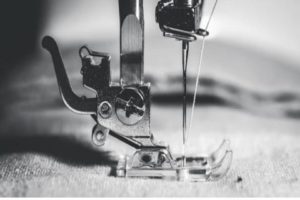
Thread tension refers to the amount of thread that can easily pass through the machine to create the stitch.
It’s quite simple, the more thread in the stitch, it would result in a looser stitch.
In the case of less thread, the stitch would be tighter.
A dial on the machine’s thread path controls the top thread tension.
So it is important to make sure the thread sits properly between the tension discs while threading the machine.
In case if it doesn’t, then the sewing machine would not be able to sew properly.
Plus, While your presser foot is up, the tension discs are open enough and therefore there is no tension on the top thread.
This is the reason behind lots of loops when you sew with the presser foot up. The problem is that it does help to properly get the thread between the discs when the foot is up as you thread the machine.
What tension should my sewing machine be on?
Usually, thread tension is considered an important issue but is misunderstood by many, that’s why it would be better to learn more about it.
Keep reading the article to understand the correct sewing machine tension.
Correct tension on a sewing machine
Both needle thread tension (top) and bobbin (bottom) affect the quality of your stitch.
Normally, when we discuss tension with sewing machines, needle tension is what is commonly being discussed.
The thing is that bobbin tension is also a factor that can easily be adjusted, that’s a different thing that it normally does not need to be.
So, the tension comes down to how much thread is allowed for each stitch.
Loose tension enables more thread, and tight tension enables less.
Just keep in mind that if your sewing machine tension is good, your stitches will look quite normal.
Well, if the stitch looks off, it indicates that you need to adjust the tension.
This usually happens most often while working with different fabrics.
If working with the same fabric, there is no need to adjust the tension unless your machine is broken.
Furthermore, Most projects will remain the same from start to finish.
For instance, when making a quilt top doing a straight stitch on the same fabric, the tension should not change.
But, while making a flannel shirt and sewing thick layers, you might need to adjust the tension during the course of that project.
There is no need to adjust your bobbin tension if you have a drop-in bobbin.
In the case of other styles of bobbins, you may have to adjust your bobbin tension.
If you desire to learn more about adjusting your bobbin tension, it would be better to find a guide that is focused on the specific kind of bobbin you have.
When to adjust the tension on a sewing machine?
While moving to a new sewing project, you may need to adjust your tension.
But, if working on the same kind of fabric, you usually do not have to worry about it.
According to sewing experts, the beginning of a project is considered the best time to evaluate the need to adjust tension.
The other situation where you need to adjust tension would be if you notice some problem with your tension.
The first most important thing that you should do if you realize the need to adjust the tension problem is rethreading your needle.
Make sure that the needle is threaded correctly, if not, the tension will not be correct.
So even after you have rethreaded, and still the problem is not resolved, just check over your machine and see whether everything is in working order or not. After that, ask yourself a few questions.
- Whether the size of the needle is correct or not?
- Is your needle threaded properly?
- Are the bobbin and needle in good condition?
How to find where the trouble is?
In order to find out where the trouble is, a thread tension test is required which simply involves sewing a few stitches.
The most appropriate way to do a tension test is to have one color for the bottom thread and another for the top.
This enables you to spot problems more easily. Well, it is also possible to use the same thread for both and still manage to spot tension problems.
Usually, there is not a specific number of stitches that are important to do, you can start with five to ten stitches.
Ensure that you have enough to evaluate the tension properly.
Also, it is recommended to use the same fabric for your tension test as you would be using in the project.
Well, this will help you to avoid the hustle to adjust your tension more as you start working on your project.
How to fix the problem
Once you go through all these steps, you are prepared to adjust your tension.
Tight tension is usually considered the more obvious of the two.
If you observe that tension is too tight, there are chances that the bottom thread is pulled up to the fabric’s top.
Furthermore, the stitch might look strange and may cause the fabric to bunch up.
On the other hand, If you feel like your thread tension is too tight, just loosen it by simply switching to a lower number on the dial.
Well, there is a convenient way to remember to go to a lower number in order to loosen your tension.
Just remember that both lower and loosen start with the letter L.